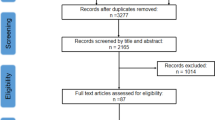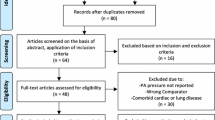Abstract
Patients with untreated obstructive sleep apnea hypopnea (OSAH) are predisposed to developing hypertension, and therapy with continuous positive airway pressure (CPAP) may reduce blood pressure (BP). The purpose of this study was to assess the impact of CPAP therapy on BP in patients with OSAH. We performed a comprehensive literature search up to July 2006 [Medline, PubMed, EMBASE, Cochrane Database of Systematic Reviews (CDSR), Cochrane controlled trials register (CCTR), and Database of Abstract and Reviews of Effect (DARE)] to identify clinical studies and systemic reviews that examined the impact of CPAP on BP. Studies were included if they (1) were randomized controlled trials with an appropriate control group, (2) included systolic and diastolic BP measurements before and after CPAP/control in patients with OSAH, and (3) contained adequate data to perform a meta-analysis. To calculate pooled results, studies were weighted by inverse variances, with either a fixed or a random effects model used depending on the presence of heterogeneity (assessed with Q test). Ten studies met our inclusion criteria (587 patients): three studies were crossover (149 patients) and seven were parallel in design. Seven studies (421 patients) used 24-h ambulatory BP and three used one-time measurements. Two studies were of patients with heart failure (41 patients). Overall, the effects of CPAP were modest and not statistically significant; CPAP (compared to control) reduced systolic BP (SBP) by 1.38 mmHg (95% CI: 3.6 to −0.88, p = 0.23) and diastolic BP (DBP) by 1.52 mmHg (CI: 3.1 to −0.07; p = 0.06). Six of the trials studied more severe OSAH (mean AHI > 30/h, 313 patients); in these six trials, CPAP reduced SBP by 3.03 mmHg (CI 6.7 to −0.61; p = 0.10) and DBP by 2.03 mmHg (CI: 4.1 to −0.002; p = 0.05). There was a trend for SBP reduction to be associated with CPAP compliance. In unselected patients with sleep apnea, CPAP has very modest effects on BP. However, we cannot exclude the possibility that certain subgroups of patients may have more robust responses—this may include patients with more severe OSAH or difficult-to-control hypertension. Future randomized controlled trials in this area should potentially concentrate on these subgroups of patients.
Similar content being viewed by others
References
Peppard PE, Young T, Palta M, Skatrud J (2000) Prospective study of the association between sleep-disordered breathing and hypertension. N Engl J Med 342(19):1378–1384
Ip M, Chung KF, Chan KN, Lam SP, Lee K (1999) Previously unrecognized obstructive sleep apnea in Chinese subjects with essential hypertension. Lung 177(6):391–400
Ayas NT, FitzGerald JM, Fleetham JA, et al. Cost-effectiveness of continuous positive airway pressure therapy for moderate to severe obstructive sleep apnea/hypopnea. Arch Intern Med 166(9):977–984
Series F, Cormier Y, Laforge J (1992) Influence of continuous positive airway pressure on sleep apnea-related desaturation in sleep apnea patients. Lung 170(5):281–290
Patel SR, White DP, Malhotra A, et al. (2003) Continuous positive airway pressure therapy for treating sleepiness in a diverse population with obstructive sleep apnea: results of a meta-analysis. Arch Intern Med 163:565–571
Blood Pressure Lowering Treatment Trialists’ Collaboration (2003) Effects of different blood-pressure-lowering regimens on major cardiovascular events: results of prospectively-designed overviews of randomised trials. Lancet 362:1527–1535
Fleiss JL (1986) Analysis of data from multiclinic trials. Controlled Clin Trials 7:267–275
Engleman HM, Gough K, Martin SE, et al. (1996) Ambulatory blood pressure on and off continuous positive airway pressure therapy for the sleep apnea/hypopnea syndrome: effects in “non-dippers”. Sleep 19(5):378–381
Ziegler MG, Mills PJ, Loredo JS, et al. (2001) Effect of continuous positive airway pressure and placebo treatment on sympathetic nervous activity in patients with obstructive sleep apnea. Chest 120(3):887–893
Dimsdale JE, Loredo JS, Profant J (2000) Effect of continuous positive airway pressure on blood pressure : a placebo trial. Hypertension 35(1 Pt 1):144–147
Mansfield DR, Gollogly NC, Kaye DM, et al. (2004) Controlled trial of continuous positive airway pressure in obstructive sleep apnea and heart failure. Am J Respir Crit Care Med 169(3):361–366
Bao X, Nelesen RA, Loredo JS, et al. (2002) Blood pressure variability in obstructive sleep apnea: role of sympathetic nervous activity and effect of continuous positive airway pressure. Blood Press Monit 7(6):301–307
Faccenda JF, Mackay TW, Boon NA, Douglas NJ (2001) Randomized placebo-controlled trial of continuous positive airway pressure on blood pressure in the sleep apnea-hypopnea syndrome. Am J Respir Crit Care Med 163(2):344–348
Arias MA, Garcia-Rio F, Alonso-Fernandez A, Martinez I, Villamor J (2006) Pulmonary hypertension in obstructive sleep apnoea: effects of continuous positive airway pressure: a randomized, controlled cross-over study. Eur Heart J 27(9):1106–1113
Norman D, Loredo JS, Nelesen RA, et al. (2006) Effects of continuous positive airway pressure versus supplemental oxygen on 24-hour ambulatory blood pressure. Hypertension 47(5):840–845
Barnes M, Houston D, Worsnop CJ, et al. (2002) A randomized controlled trial of continuous positive airway pressure in mild obstructive sleep apnea. Am J Respir Crit Care Med 165(6):773–780
Monasterio C, Vidal S, Duran J, et al. (2001) Effectiveness of continuous positive airway pressure in mild sleep apnea-hypopnea syndrome. Am J Respir Crit Care Med 164(6):939–943
Barnes M, McEvoy RD, Banks S, et al. (2004) Efficacy of positive airway pressure and oral appliance in mild to moderate obstructive sleep apnea. Am J Respir Crit Care Med 170(6):656–664
Pepperell JC, Ramdassingh-Dow S, Crosthwaite N, et al. (2002) Ambulatory blood pressure after therapeutic and subtherapeutic nasal continuous positive airway pressure for obstructive sleep apnoea: a randomised parallel trial. Lancet 359(9302):204–210
Usui K, Bradley TD, Spaak J, et al. (2005) Inhibition of awake sympathetic nerve activity of heart failure patients with obstructive sleep apnea by nocturnal continuous positive airway pressure. J Am Coll Cardiol 45(12):2008–2011
Kaneko Y, Floras JS, Usui K, et al. (2003) Cardiovascular effects of continuous positive airway pressure in patients with heart failure and obstructive sleep apnea. N Engl J Med 348(13):1233–1241
Barbe F, Mayoralas LR, Duran J, et al. (2001) Treatment with continuous positive airway pressure is not effective in patients with sleep apnea but no daytime sleepiness. a randomized, controlled trial. Ann Intern Med 134(11):1015–1023
Becker HF, Jerrentrup A, Ploch T, et al. (2003) Effect of nasal continuous positive airway pressure treatment on blood pressure in patients with obstructive sleep apnea. Circulation 107(1):68–73
Campos-Rodriguez F, Grilo-Reina A, Perez-Ronchel J, et al. (2006) Effect of continuous positive airway pressure on ambulatory BP in patients with sleep apnea and hypertension: a placebo-controlled trial. Chest 129(6):1459–1467
Robinson GV, Smith DM, Langford BA, Davies RJ, Stradling JR (2006) Continuous positive airway pressure does not reduce blood pressure in nonsleepy hypertensive OSA patients. Eur Respir J 27(6):1229–1235
West SD, Jones DR, Stradling JR (2006) Comparison of three ways to determine and deliver pressure during nasal CPAP therapy for obstructive sleep apnoea. Thorax 61(3):226–231
Logan AG, Tkacova R, Bradley TD, et al. (2003) Refractory hypertension and sleep apnoea: effect of CPAP on blood pressure and baroreflex. Eur Respir J 21(2):241–247
Yokoe T, Minoguchi K, Matsuo H, et al. (2003) Elevated levels of C-reactive protein and interleukin-6 in patients with obstructive sleep apnea syndrome are decreased by nasal continuous positive airway pressure. Circulation 107(8):1129–1134
Ip MS, Tse HF, Lam B, Tsang KW, Lam WK (2004) Endothelial function in obstructive sleep apnea and response to treatment. Am J Respir Crit Care Med 169(3): 348–353
Lavie L, Vishnevsky A, Lavie P (2004) Evidence for lipid peroxidation in obstructive sleep apnea. Sleep 27(1):123–128
Marin JM, Carrizo SJ, Vicente E, Agusti AG (2005) Long-term cardiovascular outcomes in men with obstructive sleep apnoea-hypopnoea with or without treatment with continuous positive airway pressure: an observational study. Lancet 365(9464):1046–1053
Acknowledgments
Dr. Mulgrew is supported by a BC Lung fellowship and by the CIHR/HSFC IMPACT training scheme. Dr. Ayas is supported by a Michael Smith Foundation for Health Research Scholar Award, a CIHR/BC Lung Association New Investigator Award, and a Departmental Scholar Award from the University of British Columbia. This research was supported by a Michael Smith Foundation for Health Research Unit Award (Respiratory Sleep Disorders Research Unit). The funding sources had no involvement in study design, data collection, analysis, data interpretation, writing the report, or in the decision to submit the manuscript for publication.
Author information
Authors and Affiliations
Corresponding author
Additional information
Dr. Ayas has received research funding from Respironics Inc., a maker of CPAP equipment.
Rights and permissions
About this article
Cite this article
Alajmi, M., Mulgrew, A.T., Fox, J. et al. Impact of Continuous Positive Airway Pressure Therapy on Blood Pressure in Patients with Obstructive Sleep Apnea Hypopnea: A Meta-analysis of Randomized Controlled Trials. Lung 185, 67–72 (2007). https://doi.org/10.1007/s00408-006-0117-x
Accepted:
Published:
Issue Date:
DOI: https://doi.org/10.1007/s00408-006-0117-x




